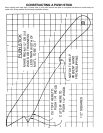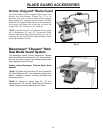
19
Fig. 56
A
Fig. 57
B
Fig. 58
USING THE FENCE AS A
CUT-OFF GAGE
WARNING: WHEN USING YOUR UNIFENCE AS A
CUT-OFF GAGE, MAKE SURE IT IS PROPERLY SET
UP AS DESCRIBED HERE.
The fence can be used as a cut-off gage when cross
cutting a number of pieces to the same length.
IMPORTANT: When using the fence as a cut-off gage, it
is very important that the rear end of the fence be
positioned so the work piece is clear of the fence before
it enters the blade. When using the fence as a cut-off
gage, position the fence (A) to the front as shown in Fig.
56, or purchase a 12" long fence (B), as shown in Fig. 57.
A typical operation using the 12" long fence (B) as a cut-
off gage is shown in Fig. 58.
Fig. 59
Fig. 60
A
RIPPING
Ripping is the operation of making a lengthwise cut
through a board, as shown in Fig. 59, and the rip fence (A)
is used to position and guide the work. One edge of the
work rides against the rip fence while the flat side of the
board rests on the table. Since the work is pushed along
the fence, it must have a straight edge and make solid
contact with the table. The saw guard must be used. The
guard has anti-kickback fingers to prevent wood
kickback, and a splitter to prevent the wood kerf from
closing and binding the blade.
Start the motor and advance the work holding it down
and against the fence. Never stand in the line of the saw
cut when ripping. Hold the work with both hands and
push it along the fence and into the saw blade as shown
in Fig. 59. The work can then be fed through the saw
blade with one or two hands. After the work is beyond the
saw blade and anti-kickback fingers, the hand is removed
from the work. When this is done the work will either stay
on the table, tilt up slightly and be caught by the rear end
of the guard or slide off the table to the floor. Alternately,
the feed can continue to the end of the table, after which
the work is lifted and brought back along the outside
edge of the fence. The cut-off stock remains on the table
and is not touched with the hands until the saw blade is
stopped, unless it is a large piece allowing safe removal.
B


















